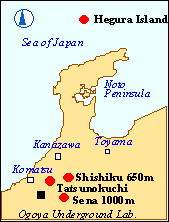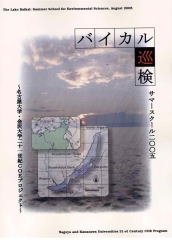Measurements of airborne 222Rn, 210Pb, 210Po and 7Be at Tatsunokuchi and Hegra Island
Kazuhisa
Komura, Ph. D., Professor |
 |
Airborne 222Rn, 210Pb, 210Po and cosmic ray induced 7Be are monitored at the Low Level Radioactivity Laboratory (LLRL) in Tatsunokuchi and Hegra Island located about 50 km offshore from Noto Peninsula and 600-800 km from opposite shore. The area of Hegra Island is only 1 km2 and is considered to be very sensitive to environmental variations of Honshu Island and also of countries of opposite shore.
Airborne radionuclides are collected on filter paper by using two (occasionally three) high volume air samplers daily at LLRL and weekly at Hegra Island. Special sampling at 1 to several hours of interval will be made in the cases of drastic weather change such as thunderstorm, typhoon, and localized heavy rain. Simultaneous sampling at Tatsunokuchi and highland (skiing field 1000 m or 650 m high) is also planned to investigate vertical distribution and mixing of airborne radionuclides and air mass movement. Sampling locations are shown in Figure 1.
 Gamma ray emitting 210Pb and 7Be are
measured by non-destructive
gamma spectrometry using ultra
low background Ge detectors in
Ogoya Underground Laboratory.
On
the other hand, 210Po is measured
by Si detector after radiochemical
separation of polonium from 1/4th
portion of air-filer. 222Rn,
which is parent of 210Pb and 210Po,
is
monitored by joint work with
Nagoya University, at 1 hour of
interval
both at Tatsunokuchi and Hegra
Island.
Gamma ray emitting 210Pb and 7Be are
measured by non-destructive
gamma spectrometry using ultra
low background Ge detectors in
Ogoya Underground Laboratory.
On
the other hand, 210Po is measured
by Si detector after radiochemical
separation of polonium from 1/4th
portion of air-filer. 222Rn,
which is parent of 210Pb and 210Po,
is
monitored by joint work with
Nagoya University, at 1 hour of
interval
both at Tatsunokuchi and Hegra
Island.
In the present study, variations of 210Pb, 210Po and 7Be can be measured with at most 1hr interval which is order of magnitute shorter than previous measurements, therefore, new information on horizontal and vertical air mass movement may be obtained.


